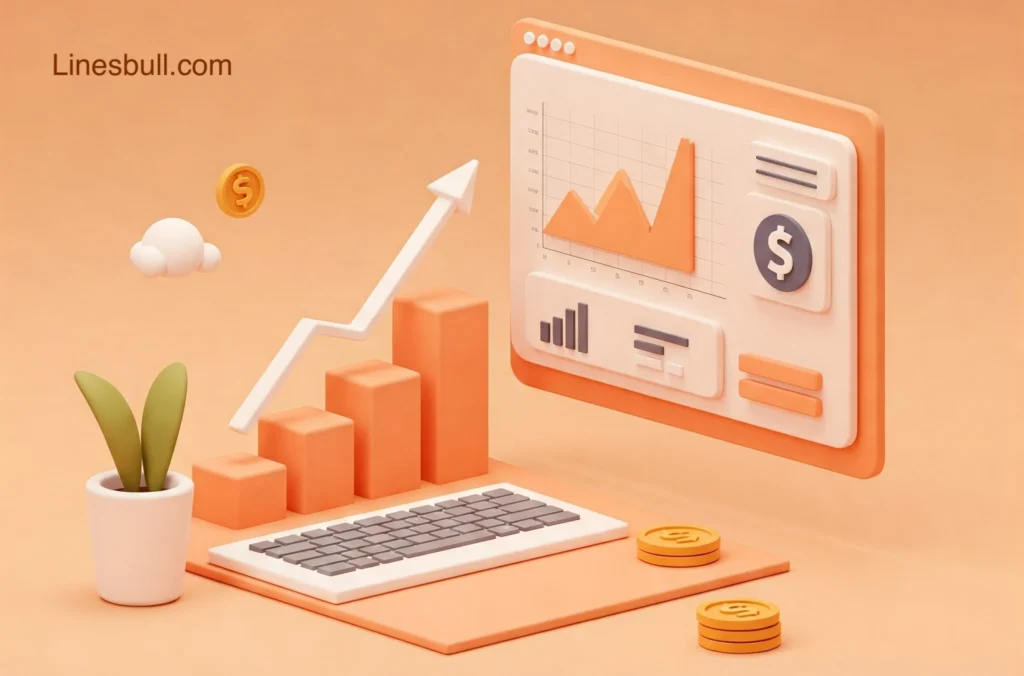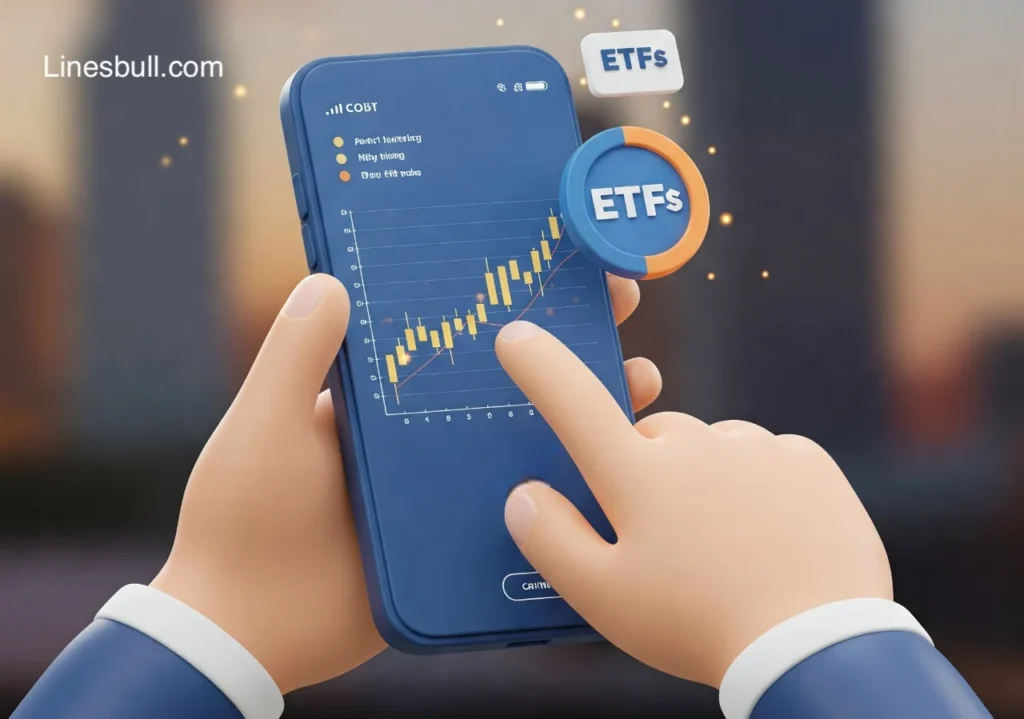Introduction
Invest in ETFs to Smart way with Nifty 50? The Nifty 50 index represents the top 50 companies listed on the National Stock Exchange (NSE) of India. These companies are industry leaders, making Nifty 50 a go-to choice for investors seeking stable returns. But what’s the best way to invest in Nifty 50? Enter ETFs (Exchange-Traded Funds), a smarter and cost-effective investment vehicle that provides exposure to the entire index.
Investing can often feel like navigating a maze, with countless options and strategies vying for your attention. Amidst this complexity, Exchange-Traded Funds (ETFs) have emerged as a straightforward and efficient path, especially when focusing on the Nifty 50 index. But why are ETFs considered the smartest way to invest in the Nifty 50? Let’s delve into this topic, exploring the benefits, top-performing ETFs, comparisons with sectoral ETFs, and a step-by-step guide to get you started.

Understanding ETFs and the Nifty 50
What are ETFs?
An Exchange-Traded Fund (ETF) is an investment fund that tracks an index, commodity, or asset and trades like a stock on exchanges. In the case of Nifty 50 ETFs, they mirror the performance of the Nifty 50 index.
ETFs vs. Mutual Funds
- Lower Costs – ETFs have lower expense ratios than actively managed mutual funds.
- Real-Time Trading – ETFs trade on stock exchanges throughout the day, unlike mutual funds, which settle at the end of the day.
- No Fund Manager – ETFs are passively managed, reducing costs and the risk of human error.
Comparisons Of ETFs vs. Mutual Funds:
| Feature | ETFs | Mutual Funds |
|---|---|---|
| Management Style | Passive | Active/Passive |
| Expense Ratio | Lower (0.05% – 0.2%) | Higher (1% – 2.5%) |
| Trading Method | Real-time like stocks | Priced at NAV, traded at the end of the day |
| Liquidity | High (Buy/Sell anytime) | Limited (Redemption takes time) |
| Fund Manager Risk | None (Tracks Index) | Present (Depends on fund manager’s strategy) |
| Tax Efficiency | More tax-efficient | Less tax-efficient |
How Do They Work?
ETFs, or Exchange-Traded Funds, are investment funds that trade on stock exchanges just like stocks. They pool money from investors to buy a diversified portfolio of assets, often tracking a specific index like Nifty 50.

Understanding the Nifty 50 Index
The Nifty 50 is India’s benchmark stock market index, representing the 50 largest and most liquid companies listed on the NSE. It provides a snapshot of the overall market performance.
Top-Performing Nifty 50 ETFs in India
Comparison of the Best Nifty 50 ETFs
| ETF Name | Expense Ratio | Liquidity | 5-Year Returns | Tracking Error |
|---|---|---|---|---|
| Nippon India ETF Nifty BeES | 0.05% | High | 15.6% | Low |
| SBI Nifty 50 ETF | 0.07% | High | 15.4% | Low |
| UTI Nifty 50 ETF | 0.10% | Medium | 15.2% | Low |
| ICICI Prudential Nifty ETF | 0.05% | High | 15.5% | Very Low |
| HDFC Nifty 50 ETF | 0.08% | Medium | 15.3% | Low |
Benefits of Investing in Nifty 50 ETFs
Diversification
A fundamental principle of investing is to diversify your assets rather than concentrating them in a single option. Nifty 50 ETFs naturally diversify your investment across 50 different companies from various sectors. This means that if one sector underperforms, the impact on your overall investment is cushioned by the performance of other sectors.
Cost-Effectiveness
Traditional mutual funds often come with higher management fees. In contrast, ETFs typically have lower expense ratios, meaning more of your money is actually working for you rather than being eaten up by fees.
Liquidity
Since ETFs are traded on stock exchanges, they offer high liquidity. This allows you to buy or sell your investment at any time during trading hours, providing flexibility that aligns with your financial goals.
Transparency
ETFs regularly disclose their holdings, so you always know exactly what you’re investing in. This transparency helps you make informed decisions and aligns your investments with your values and objectives.
Why Invest in Nifty 50 ETFs?
Why ETFs Are the Smartest Way to Invest in Nifty 50?:
1. Low-Cost Investing
One of the biggest advantages of ETFs is their low cost. Unlike mutual funds, they don’t have high management fees, making them a great choice for long-term investors.
2. Diversification Benefits
By investing in a Nifty 50 ETF, you get exposure to 50 large-cap companies across various sectors, reducing the overall risk.
3. Transparency & Liquidity
ETFs offer real-time pricing and high liquidity, making them easy to buy and sell at market prices.
4. Passive Investment Strategy
Since ETFs track the Nifty 50 index, they don’t require active management. This removes the risk of poor fund manager decisions and aligns your investment with market growth.

How to Invest in Nifty 50 ETFs? (Step-by-Step Guide)
- Establish a Demat and trading account with a brokerage firm.
- Search for Nifty 50 ETFs on your broker’s platform.
- Invest and hold the ETF in your portfolio.
How to Start Investing in Nifty 50 ETFs?
Step 1: Open a Demat & Trading Account
- Choose a broker (Zerodha, Upstox, Groww, etc.).
- Complete KYC verification.
Step 2: Fund Your Trading Account
- Transfer money from your bank to your brokerage account.
Step 3: Select a Nifty 50 ETF
- Compare expense ratios, tracking errors, and liquidity.
- Select an ETF that corresponds with your investment objectives.
Step 4: Buy ETF Units
- Search for the ETF on the trading platform.
- Place a market order (instant execution) or limit order (buy at a preferred price).
Step 5: Monitor and Hold for the Long-Term
- Track ETF performance regularly.
- Hold your investment for at least 5-10 years for better returns.
Nifty 50 ETFs vs. Direct Stock Investment
| Feature | Nifty 50 ETFs | Direct Stocks |
|---|---|---|
| Diversification | High (50 stocks) | Low (Depends on individual stock selection) |
| Risk Level | Moderate | High |
| Investment Knowledge Required | Low | High |
| Management Effort | Low | High (Need to monitor individual stocks) |
| Long-Term Returns | Consistent growth | Can be high or low, depending on stock selection |
Best Nifty 50 ETFs in India
Some of the top-performing Nifty 50 ETFs include:
- Nippon India ETF Nifty BeES
- SBI Nifty 50 ETF
- UTI Nifty 50 ETF
Before choosing an ETF, compare expense ratios, liquidity, and tracking errors.
Comparing Nifty 50 ETFs vs. Sectoral ETFs
| Feature | Nifty 50 ETFs | Sectoral ETFs |
|---|---|---|
| Diversification | High (50 stocks from multiple sectors) | Low (Stocks from a single sector) |
| Risk Level | Moderate (spread across sectors) | High (sector-specific risk) |
| Market Volatility | Lower | Higher |
| Returns Potential | Moderate, stable long-term growth | High if the sector performs well |
| Best for Investors | Looking for stable, long-term growth | Willing to take high risks for high rewards |
Conclusion
Nifty 50 ETFs offer a low-cost, diversified, and tax-efficient way to invest in India’s top companies. They provide the benefits of stock investing without the hassle of picking individual stocks. Whether you’re a beginner or an experienced investor, Nifty 50 ETFs are a smart choice for long-term wealth creation.
FAQs
1. Are Nifty 50 ETFs good for beginners?
Yes, Nifty 50 ETFs are perfect for beginners due to their simplicity, diversification, and low costs.
2. How much money do I need to start investing in Nifty 50 ETFs?
You can start with as little as ₹100, depending on the ETF’s unit price.
3. Can I lose money in Nifty 50 ETFs?
Like all investments, ETFs carry market risks. However, Nifty 50 ETFs are relatively stable in the long run.
4. Which is better, Nifty 50 ETF or mutual fund?
ETFs are cost-effective and liquid, whereas mutual funds provide professional management. Choose based on your investment goals.
5. How do I track the performance of my Nifty 50 ETF?
You can monitor your ETF’s price through stock market apps or your brokerage account.


